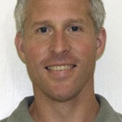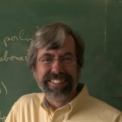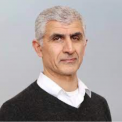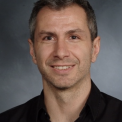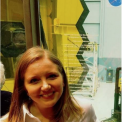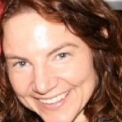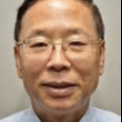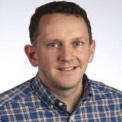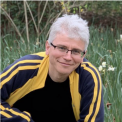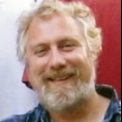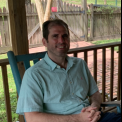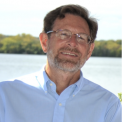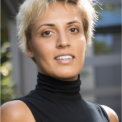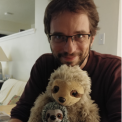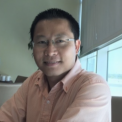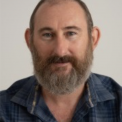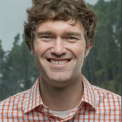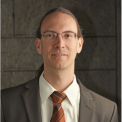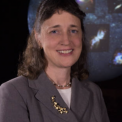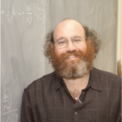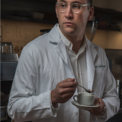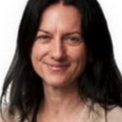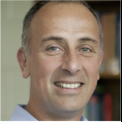Thermodynamics provides a robust conceptual framework and set of laws that govern the exchange of energy and matter. Although these laws were originally articulated for macroscopic objects, nanoscale systems also exhibit “thermodynamic- like” behavior – for instance, biomolecular motors convert chemical fuel into mechanical work, and single molecules exhibit hysteresis when manipulated using optical tweezers. To what extent can the laws of thermodynamics be scaled down to apply to individual microscopic systems, and what new features emerge at the nanoscale? I will describe some of the challenges and recent progress – both theoretical and experimental – associated with addressing these questions. Along the way, my talk will touch on non-equilibrium fluctuations, “violations” of the second law, the thermodynamic arrow of time, nanoscale feedback control, strong system-environment coupling, and quantum thermodynamics.
Events: Departmental Colloquia
-
Scaling down the laws of thermodynamics
-
Collapse of the Collapse: Physicists Return to Reality
We note the recent demise of the collapse hypothesis, that an integral part of quantum mechanics is the "collapse" of the state of a system when measured. Using recent work of Anthony Rizzi, we show that the Ensemble Interpretation provides a simple and natural resolution to the problem of measurement in quantum mechanics. Along the way, we give a fuller explanation of the Ensemble Interpretation (in spite of the familiar-sounding name, this is almost entirely unknown), measurement theory in general (correcting many common misconceptions), the resolution of the Schrodinger Cat experiment, Wigner’s Friend experiment, and the Extended Wigner’s Friend experiment. At the end we encourage discussion of how to deal with the pedagogical situation, given that almost all current QM textbooks are based on the (now defunct) collapse hypothesis.
-
Rydberg impurity in a quantum gas: a molecular Lego with quantum statistics
Impurity physics is a celebrated sub-discipline in condensed matter. Spectroscopy of impurity dynamics in atomic quantum Bose and Fermi gases has invigorated this line of research. Here, I will describe steps we've taken toward understanding how Rydberg quenches in such gases probe quantum correlations and quantum statistics, how oligomeric Rydberg molecules evolve to many-body dressed states and how Fermi statistics inhibits chemical reactivity. I will also touch upon cases when impurity excitations are not isotropic with implications for engineering chiral interactions.
-
Breaking Speed and Resolution Limitations of AFM
High-speed atomic force microscopy (HS-AFM) is a powerful technique that provides dynamic movies of biomolecules at work. We successfully used HS-AFM to take movies – and determine dynamic parameters – of membrane trafficking systems such as ESCRT-III and clathrin, transporters and channels.
To break current temporal limitations to characterize molecular dynamics using HS-AFM, we developed HS-AFM height spectroscopy (HS-AFM-HS), a technique whereby we oscillate the HS-AFM tip at a fixed position and detect the motions of the molecules under the tip. This gives sub- nanometer spatial resolution combined with microseconds temporal resolution of molecular fluctuations. HS-AFM-HS can be used in conjunction with HS-AFM imaging modes, thus giving access to a wide dynamic range.
To break current resolution limitations, we developed Localization AFM (LAFM). By applying localization image reconstruction algorithms to peak positions in high-speed AFM and conventional AFM data, we increase the resolution beyond the limits set by the tip radius and reach quasi-atomic resolution on soft protein surfaces in native and dynamic conditions. The LAFM method allows the calculation of high-resolution maps from either images of many molecules or many images of a single molecule acquired over time, opening new avenues for single molecule structural analysis.
-
Chronicles of the Unknown: Webb Science across the Universe into the Solar System
In late 2021, scientific innovation will take the next step into space exploration and journey. The James Webb Space Telescope (sometimes called JWST or Webb), an orbiting infrared observatory that will complement and extend the discoveries of the Hubble Space Telescope but with longer wavelength coverage and greatly improved sensitivity, will launch into space on an Ariane 5 rocket from French Guiana. Webb will be the premier observatory of the next decade, serving thousands of astronomers and planetary scientist worldwide. It will study every phase in the history of our Universe, ranging from the first luminous glows after the Big Bang, to the formation of solar systems capable of supporting life on planets like Earth, to the evolution of our own Solar System. The discovery space for small bodies in the Solar System with Webb is unprecedented and will reveal new insights to planetesimal formation, composition, and distribution. Physically characterizing planetesimals throughout the solar system is often challenging via remote observations because of their combination of dark surfaces, extreme distances, and some diagnostic spectral features only distinguishable beyond Earth’s atmosphere. JWST's discoveries for these small bodies are expected to reveal the presence of previously unseen molecular gases and ices, constrain their physical state (e.g., crystalline phase and grain-size), and measure isotopic ratios of volatile elements (H, O, C, N). Additionally, imaging at longer wavelengths can be used to study temperature variations on larger bodies (Parker et al. 2016). In this talk, I will provide a status update of the Webb Telescope, briefly review the main science themes for JWST, and conclude with anticipated science from JWST's exploration of the objects in our Solar System, namely small bodies.
-
The Local Gaseous Universe
Most of the normal matter in the universe is in gaseous form. Stars form in galaxies when some of this gas settles into the central regions of their potential wells. In this talk, I will discuss the distribution of gas in and around galaxies in the nearby universe using ultraviolet absorption line and hydrogen emission line observations. The gas surrounding the Milky Way will be compared to other galaxies, and the gas within dwarf galaxies, the smallest galaxies in the universe, will be considered in the context of the gas surrounding larger galaxies. The flow of gaseous matter dictates the structure and fate of all types of galaxies.
-
Research Grant Proposals Reviewers Dynamics
As we all are concerned with maintaining stable research support, we seek the best strategy for winning competitive research grants. It becomes imperative to better understand the evaluation process. While in the midst of the ever-increasing competition, the most popular evaluation means is peer review. Such basic questions as how the peer review is carried out, how the reviewers selected, what do the reviewers think when they encounter a research grant proposal to review, and what they like/don’t like are some of the questions that will be discussed. Other pertinent questions are expected to come from the listeners and participants.
-
Gas Flows in the Milky Way Halo
Gas flows play crucial roles in galaxy evolution. Inflowing gas provides fuel for star formation, whereas outflowing gas carries away the products of earlier generations of stars. In the Milky Way, we have a front-row seat for viewing the multi-phase gas flows that circulate material from the disk to the halo and back. I will focus on two prominent examples of gas flows: the Fermi Bubbles, a giant pair of outflowing lobes surrounding the Galactic Center, and the Magellanic Stream, an interwoven tail of filaments trailing the Magellanic Clouds as they orbit the Milky Way. I will discuss recent ultraviolet observations from the Hubble Space Telescope, which have provided new insight into the origin of the Fermi Bubbles and the Magellanic Stream. These observations have helped reveal the mechanisms by which the Milky Way exchanges mass with its surroundings and fuels its ongoing star formation.
Related Papers:
1) The Magellanic Stream: Circumnavigating the Galaxy
https://ui.adsabs.harvard.edu/abs/2016ARA%26A..54..363D/abstract2) Probing the Fermi Bubbles in Ultraviolet Absorption: A Spectroscopic Signature of the Milky Way's Biconical Nuclear Outflow
https://ui.adsabs.harvard.edu/abs/2015ApJ...799L...7F/abstract -
Using information to learn what matters
Information theory was formulated by Shannon as the theory of communication. However, it has become a popular tool for answering a related — but a different — set of questions: namely, which features of a system are essential for its description, and therefore, must be preserved in a model describing it? These tools were developed largely in the context of biophysical systems, where traditional theoretical physics toolbox is insufficient to identify the relevant terms. I will walk us through a series of examples in different experimental biological and synthetic systems, where information theory has been used in this way.
-
Water on the Lunar Surface: To be or not to be?
The sources of molecular water in planetary systems is a subject of general interest in astrophysics and astrochemistry and its presence and persistence are critical for space missions involving long term human exploration. The Moon is the nearest exploration target and sources of water include primordial water, delivery via comets and meteorites, formation and release during small impact events, and solar wind interactions. An additional source term of molecular water is the thermally activated process known as recombinative desorption (RD) or associative desorption (AD) from lunar regolith grains. This involves hydroxyl (-OH) defects that were made by implantation of solar wind protons. Using several Apollo lunar samples, temperature program desorption (TPD) experiments conducted under ultra-high vacuum conditions yielded first order activation energies for desorption of chemisorbed molecular water and second order activation energies for the RD mediated formation and release of molecular water. Depending on the temperature excursions, RD can occur on a diurnal basis and is likely prevalent during impacts with meteorites and meteoroids. Once formed, the water can either desorb, or be transported on and within the regolith. Our combined experimental and modeling effort has successfully simulated recent observational data. Water formation via RD is likely general under astrophysical conditions that involve proton bombardment followed by thermal excursions ( > 400 K), and is critical to developing strategies for extraction of water for future, sustainable human space exploration missions.
-
Quantum Entanglement: Applications in Communication and Cryptography
Quantum entanglement is a key phenomenon that separates the classical and quantum theories of information. In this talk, I will begin by introducing the notion of entanglement and discuss its applications, beginning with fundamental protocols like teleportation, super-dense coding, and the CHSH game. Then I will progress to more sophisticated topics like various communication capacities of quantum channels and highlight the role of entanglement in each of them. Key references include https://arxiv.org/abs/1106.1445 and https://arxiv.org/abs/2011.04672.
About the Speaker
Mark M. Wilde is an Associate Professor in the Department of Physics and Astronomy and the Center for Computation and Technology at Louisiana State University. He is a recipient of the Career Development Award from the US National Science Foundation, co-recipient of the 2018 AHP-Birkhauser Prize from the journal Annales Henri Poincare, and Associate Editor for Quantum Information Theory at IEEE Transactions on Information Theory and New Journal of Physics. His current research interests are in quantum Shannon theory, quantum optical communication, quantum computational complexity theory, and quantum error correction.
-
Moire Superpotentials and Quantum Calligraphy of Single Photon Emitters in van der Waals Heterostructures
Single photon emitters (SPEs), or quantum emitters, are key components in a wide range of nascent quantum-based technologies. A solid state host offers many advantages for realization of a functional system, but creation and placement of SPEs are difficult to control. We describe here a novel paradigm for encoding strain into 2D materials to create and deterministically place SPEs in arbitrary locations with nanometer-scale precision [1]. We demonstrate the direct writing of SPEs in 2D semiconductors based on a materials platform consisting of a WSe2 monolayer on a deformable substrate using an atomic force microscope nano-indentation process. This quantum calligraphy allows deterministic placement and real time design of arbitrary patterns of SPEs for facile coupling with photonic waveguides, cavities and plasmonic structures.
The weak interlayer bonding in van der Waals heterostructures (vdWh) enables one to rotate the layers at arbitrary azimuthal angles. For transition metal dichalcogenide vdWh, twist angle has been treated solely through the use of rigid-lattice moiré patterns. No atomic reconstruction has been observed to date, although reconstruction can be expected to have a significant impact on all measured properties, and its existence will fundamentally change our understanding of such systems. Here we demonstrate via conductive AFM and TEM that vdWh of MoSe2/WSe2 and MoS2/WS2 undergo significant atomic level reconstruction at twist angles ≤ 1° leading to discrete commensurate domains divided by narrow domain walls [2], rather than a smoothly varying rigid-lattice moiré pattern as has been assumed in prior work. We show that this occurs because the energy gained from adopting low energy vertical stacking configurations is larger than the accompanying strain energy [3]. Such reconstruction impacts both the local conductivity and the optical properties.
About the Speaker
Berend T. Jonker is the Senior Scientist for Magnetoelectronic Materials in the Materials Science & Technology Division at the Naval Research Laboratory, Washington, DC. His current research interests include spintronics, 2D materials, and topological materials. Dr. Jonker is a Fellow of the American Physical Society (APS), the American Association for the Advancement of Science (AAAS), and of the American Vacuum Science Society (AVS). He is the recipient of the Meritorious Presidential Rank Award, the NRL Hulburt Award, the Sigma Xi Award for Pure Science, several NRL Tech Transfer Awards, the Dolores M. Etter Navy Scientist Award, and others. He has served as chair for the APS Topical Group on Magnetism, and for the AVS Magnetic Interfaces Division. Dr. Jonker obtained his Ph.D. in solid state physics from the University of Maryland in 1983. He has published over 270 articles in refereed journals, 5 book chapters, co-authored 17 patents, and presented over 140 invited lectures.
-
Controlling Correlations: Linear-, Nonlinear-, and Hydrodynamics in Quantum Materials
The physics of quantum materials hosts spectacular excited-state and nonequilibrium effects, but many of these phenomena remain challenging to control and, consequently, technologically under-explored. My group’s research, therefore, focuses on how quantum systems behave, particularly away from equilibrium, and how we can harness these effects1. By creating predictive theoretical and computational approaches to study dynamics, decoherence and correlations in materials, our work could enable technologies that are inherently more powerful than their classical counterparts ranging from scalable quantum information processing and networks, to ultra-high efficiency optoelectronic and energy conversion systems. In this talk, I will present work from my research group on describing, from first principles, the microscopic dynamics, decoherence and optically-excited collective phenomena in quantum matter at finite temperature to quantitatively link predictions with 3D atomic-scale imaging, quantum spectroscopy, and macroscopic behavior. Capturing these dynamics poses unique theoretical and computational challenges. The simultaneous contribution of processes that occur on many time and length-scales have remained elusive for state-of- the-art calculations and model Hamiltonian approaches alike, necessitating the development of new methods in computational physics2–4. I will show selected examples of our approach in ab initio design of active defects in quantum materials5–7, and control of collective phenomena to link these active defects8–10. Building on this, in the second part of my seminar, I will show our predictions of linear and nonlinear dynamics and transport in Weyl semimetals11–14. I will discuss the anomalous landscape for electron hydrodynamics in systems beyond graphene, highlighting that previously- thought exotic fluid phenomena can exist in both two-dimensional and anisotropic three-dimensional materials15. Our work identifies phonon-mediated electron-electron interactions16–18 as critical in a microscopic understanding of hydrodynamics. Non-diffusive electron flow, and in particular electron hydrodynamics, has far-reaching implications in quantum materials science, as I will show in this talk. Finally, I will present an outlook on driving topological quantum materials far out-of-equilibrium to control the coupled degrees-of-freedom19,20.
About the Speaker
Prineha Narang is an Assistant Professor at the John A. Paulson School of Engineering and Applied Sciences at Harvard University. Prior to joining the faculty, Prineha came to Harvard as a Ziff Fellow and worked as a Research Scholar in Condensed Matter Theory at the MIT Department of Physics. She received an M.S. and Ph.D. in Applied Physics from the California Institute of Technology (Caltech). Prineha’s work has been recognized by many awards and special designations including a National Science Foundation CAREER Award in 2020, being named a Moore Inventor Fellow by the Gordon and Betty Moore Foundation, CIFAR Azrieli Global Scholar by the Canadian Institute for Advanced Research, a Top Innovator by MIT Tech Review (MIT TR35), and a Young Scientist by the World Economic Forum in 2018. In 2017, she was named by Forbes Magazine on their “30under30” list for her work in quantum science and engineering. Outside of science, she is an avid triathlete and runner.
Website: narang.seas.harvard.edu
-
Using machine learning to build robust interatomic potentials
Machine learning is emerging as a powerful tool for emulating electronic structure calculations. I will discuss recent work in building interatomic potentials relevant to chemistry, materials science, and biophysics applications. A key idea is active learning, in which the training data is iteratively collected to address weaknesses of the ML model. This approach can achieve a surprising level of transferability, as will be demonstrated with a case study for elemental aluminum.
About the speaker:
Kipton Barros has interests in computational physics, applied math, and computer science, and currently works in the Physics and Chemistry and Materials group at Los Alamos National Lab. A recent focus is applying machine learning to accelerate simulations and scientific discovery. Over the past few years, collaborations have spanned topics such as seismology, molecular dynamics simulation, fluid dynamics, and correlated electron physics. -
Recent Discoveries in Two-Dimensional van der Waals Magnets: Opportunities and Challenges
Two-dimensional (2D) magnetic van der Waals materials, especially transition metal dichalcogenides (TMDCs), and their heterostructures are emerging candidates for ultralow-power and ultra-compact device applications. Although theory predicts suppression of long-range magnetic order at finite temperatures in such 2D materials, recent experiments have demonstrated the existence of long-range ferromagnetic order in bulk van der Waals materials (e.g., CrI3) at the monolayer limit [1,2]. However, these materials require cryogenic temperatures or other special protections to function. Therefore, it becomes crucial to have control over their unique atomic- level magnetism at temperatures close to room temperature, at which most of our devices operate. To this end, our recent discoveries of the strong room temperature ferromagnetism in metallic monolayers of VSe2 grown on van der Waals substrates (graphite, MoS2) [3] and semiconducting monolayers of V-doped WSe2 or WS2 grown on SiO2 substrates [4,5] have the potential to transform the fields of spintronics, valleytronics and quantum computation. In this talk, I will present the research progress on 2D magnetism, including our new findings of the light-controlled room temperature ferromagnetism in 2D V-doped TMDCs, the tunable exchange bias effect and light-mediated magnetism in VSe2/MoS2 heterostructures, as well as the development of a new class of highly sensitive magnetic sensor using a single layer magnet of VSe2 [6]. Opportunities and challenges in this rapidly expanding research field will be discussed.
About the Speaker
Dr. Phan is Professor of Physics at the University of South Florida. He received B.S., M.S., and Ph.D. degrees in Physics from Vietnam National University (2000), Chungbuk National University – South Korea (2003), and Bristol University – UK (2006), respectively. His research interests lie in the physics and applications of magnetic materials, with an expertise on the development of novel magnetocaloric and magnetoimpedance materials for energy-efficient magnetic refrigeration and smart sensor technologies. He has published more than 280 peer-reviewed journal papers (over 10,000 citations, h-index: 51 from Google Scholar), 7 review papers, 5 book chapters, and 1 text book. Presently, he serves as an Editor for the Journal of Electronic Materials, the Editor for Applied Sciences, the Managing Editor for Journal of Science: Advanced Materials and Devices, and the Editorial Board Member of Nature: Scientific Reports. He has recently been awarded an Honorary Doctoral Degree by Vietnam National University - Hanoi (2021). He was also the recipient of The Two USF Outstanding Faculty Research Achievement Awards (2017, 2019), the recipient of The USF Outstanding Graduate Faculty Mentor Award (2018, HM), and the recipient of The Medal for His International Contribution and Recognition by Vietnam National University - Hanoi (2018). He has delivered plenary, keynote and invited talks at professional meetings on Magnetism and Magnetic Materials (MMM, ICM, APS, MRS, INTERMAG, TMS, ICAM, ICAMR, ISAMMA, IcAUMS) and organized numerous international conferences on Nanomaterials, Energy, and Nanotechnology.
-
Electron - electron Correlations, Making & Breaking Chemical Bonds
I will describe our recent progress in the combined experimental and theoretical study of single-photon double-ionization process and the Coulomb explosion dynamics that it triggers in small molecules. In particular, I will describe the roaming H2 dynamics and formation of the H3+ cation and demonstrate how molecular dynamics measurements help identify the spin-correlation of the electron-pair, ejected in single-photon double-ionization of methanol.
-
The exciting world of lanthanide-based nanoparticles: from photon avalanches to nanoscale lasers
Though their unique optical properties are proving advantageous for numerous applications, an ongoing challenge facing upconverting nanoparticles (UCNPs) remains achieving satisfactory upconverted signal and quantum yield while illuminating at low fluences. Here, I will describe the pros and cons of various strategies used to improve UCNP signals and efficiencies, which are pushing UCNP brightness to unprecedented levels. Of particular note here are advances in dye-sensitized UCNPs,1 high-lanthanide-content compositions,2,3 exploitation of stimulated emission,4,5 and, most recently, the realization of photon avalanching lanthanide-based nanoparticles.6 The impact of these concepts is now being widely felt in fields spanning deep-tissue imaging, optogenetics, remote sensing, anti-counterfeiting, and solar light harvesting
-
Listening to the ultrafast chat of two excited electrons — and asking them some quick physics questions
The matter we see around us consists of atoms with attached electrons, pairwise “glueing” atoms together in molecules, and giving objects their color by resonantly interacting with light. This talk starts out with how the strong electric fields of intense pulsed lasers can probe and modify the electron pair within the helium atom. Our experiments reveal a time-domain picture of absorption with a link between a laser- controllable phase and the Fano resonance. The same general physics mechanism currently unlocks new science areas ranging from laser- driven large solution-phase molecular dynamics to precision spectroscopy with hard-x-ray light.
-
Quantum Turbulent Structure in Light
A random superposition of plane waves is known to be threaded with vortex line singularities which form complicated tangles and obey strict topological rules. In this work, we use both numerical simulations of random waves and experiments on laser speckle to observe and characterize the dynamics of the vortex tangles. We find that the velocity statistics of the vortices in random waves match those of turbulent quantum fluids such as superfluid helium and atomic Bose- Einstein condensates (Physical Review Letters 122, 044301 2019). These statistics are shown to be independent of system scale. These results raise deep questions about the role of nonlinearity in the structure of turbulence and the general nature of quantum chaos.
-
The Hubble Space Telescope: 30 Years of Cosmic Discovery
The Hubble Space Telescope is operating at peak scientific capability even 30 years after its launch, thanks to successful astronaut servicing missions and operations that keep the observatory in top condition. I will review the premiere scientific advancements achieved by Hubble, including both those that were planned at launch (e.g. measuring the Hubble constant) and many that were never dreamed of at launch (e.g. finding evidence for dark energy; analyzing exoplanet atmospheres). Hubble and ground-based observations together led to the discovery of the accelerating expansion of the universe and a resulting Nobel Prize. Hubble observations are now driving new quests in Multi-Messenger Astronomy and in revealing fundamental discrepancies in cosmological measurements. Hubble programs are also preparing the field for JWST, the Roman Space Telescope, and other future missions, and are contributing critical data in coordination with ground-based observatories and solar system probes like JUNO. I will discuss how Hubble can be used in its coming final years to provide the best science return, complementing other space-based and ground-based observatories and setting the stage for future breakthroughs in astrophysics.
-
Social Physics: Data-Driven Analysis and Computational Modelling of Human Social Connectome
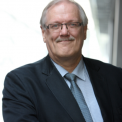
Guest: Kimmo Kaski, Aalto University School of Science, Finland The Alan Turing Institute, British Library, UK Wolfson College & CABDyN Complexity Cent, Said Business School, Oxford University, UK Complexity Science Hub Vienna, Austria
Thursday, October 22, 2020 3:55 pm - 4:55 pm
Location: Zoom Meeting https://zoom.us/j/97410561833The study of large-scale socially relevant datasets using Network Theory based data analysis and computational modelling approaches yield unprecedented insight into human sociality and social/societal structures and behavioural processes. This is well-demonstrated by our analysis of large mobile phone dataset, confirming the Granovetterian picture of social networks being modular, having communities with strong internal ties and linked with weaker external ties {1}. As the data also includes mobile phone users’ demographics, i.e. gender and age, we have studied the nature of human social interactions from Dunbarian egocentric viewpoint and got a deeper insight into the gender and age-related social behaviour patterns and dynamics of human relationships, across their lifespan {2}. With the help of open geophysical (sunrise, sunset, length of daylight), seasonal (daily temperature) and geographical (population distribution) data, we investigated the influence of seasonality and geographical location on human activity patterns, observing two daily inactivity/resting periods, such that the nocturnal resting period is influenced by the length of daylight and latitudinal location the person lives, and the afternoon resting period by the temperature, and that the afternoon and nocturnal resting periods appear to be counterbalancing each other {3,4}. To get deeper understanding of the above-described phenomena, the next step is to develop models of human sociality, social/societal networks and processes of their formation and information spreading. One of our models, based on network sociology mechanisms for making friends, produced many empirically observed Granovetterian features of social networks, such as meso- scale community and macro-scale topology formation {5,6}. In subsequent models we investigated the roles of social networks being layered, multiplexing or context based, geography dependent, and having relationships between people changing in time. In sum, the large-scale data-driven analytics and modelling approaches to social systems opens up an unprecedented perspective to gain understanding of human sociality from individual to societal level, which with the availability of various socially relevant datasets and development of computational methodologies could lead to tools of social and societal design.
-
The physics of life: Taking theory seriously
Theoretical physics is the search for compact and compelling mathematical descriptions of the world around us. This is an ambitious, and extraordinarily successful, activity. We can predict what is seen when we look deep into the atomic nucleus and deep into the farthest reaches of space. But the phenomena of life have largely evaded the powerful predictive umbrella of theoretical physics.
In recent years we have seen glimpses of what a theoretical physics of living systems might look like. We have been able to go from general principles to the properties of particular systems, with examples ranging from developing embryos to coding and computation in the brain and the emergence of order in flocks of birds. It is especially exciting to see agreement between theory and experiment with “physics level” precision in the complex context of living organisms. I’ll give a survey of these ideas, and point to what might come in the next few years.
-
Systematically improving coffee: mathematics and experiment
Numerous physical and chemical processes play a determining role in cup quality, ranging from agricultural practices, to roasting and brewing. This talk canvases the landscape of coffee research to date, detailing areas that require further study, as well as discussing our early efforts to better understand the key factors that determine cup quality and reproducibility. The talk will touch on three key research areas; the chemistry of water, the physics of grinding (including cryogenics), and our latest endeavors of using mathematical modeling to improve espresso reproducibility.
-
Our Astrochemical Origins
Our Solar System was born from a dark and cold cloud made out of molecular gas and small dust particles. Thanks to powerful telescopes, we can now study in detail these clouds, their chemical ingredients and their evolution. We can then reconstruct our origins. Interstellar molecules are unique tracers of the dynamical and chemical evolution of star and planet forming regions. Thus, astrochemistry is crucial to test theories and shed light on our origins. In this talk I shall review the chemical and physical structure of interstellar clouds, where stars and planets are formed, as well as theoretical work on protoplanetary disk formation and early evolution. Links to our Solar System will be made.
-
Quantum computing over the rainbow: the quantum optical frequency comb as a platform for measurement-based universal quantum computing
An ultrafast laser emits vastly multimode light over a broad spectral band, a.k.a. the optical frequency comb (OFC), but the emission happens but one photon at a time, if in a stimulated manner, and no entanglement is created in the light. Changing the gain medium from linear (one- photon) to nonlinear (two-photon) yields an optical parametric oscillator which features massively multipartite entanglement of the OFC modes, as demonstrated experimentally by our group and others. This entanglement can then be exquisitely tailored to cluster states with specific graphs, in particular the two-dimensional ones that are universal for measurement-based, one-way quantum computing. It is worth noting that this requires only sparse experimental resources that are highly compatible with integrated optics, thereby paving the way to the realization of practical, fault- tolerant quantum computers.
Join Zoom Meeting: https://zoom.us/j/97410561833
Page 2 of 11, showing 25 records out of 274 total, starting on record 26, ending on 50


